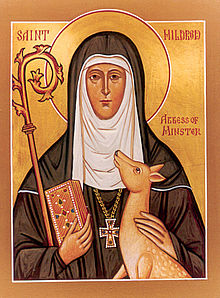|
Mildrith
 Saint Mildrith, also Mildthryth, Mildryth and Mildred, (Old English: Mildþrȳð) (born c. 660, died after 732), was a 7th- and 8th-century Anglo-Saxon abbess of the Abbey at Minster-in-Thanet, Kent. She was declared a saint after her death, and, in 1030, her remains were moved to Canterbury. Life and familyMildrith was the daughter of King Merewalh of Magonsaete, an area similar to the present day Herefordshire, a sub-kingdom of Mercia. Her mother was Domne Eafe (also sometimes named as Saint Eormenburga),[1] herself a great-granddaughter of Æthelberht of Kent, and as such appearing in the so-called Kentish Royal Legend. Her sisters Milburga of Much Wenlock and Mildgyth were also considered saints, and Mildrith, along with her extended family, features in the Kentish Royal Legend, also known as the "Mildrith Legend".[2] In the 11th century, Goscelin wrote a hagiography of Mildrith, the Vita Mildrethae.[3] Another work, the Nova Legenda Anglie of 1516, gives an extensive account of her life. Mildrith's maternal family had close ties to the Merovingian rulers of Gaul, and Mildrith is said to have been educated at the prestigious Merovingian royal abbey of Chelles.[1] She entered the abbey of Minster-in-Thanet, which her mother had established, and became abbess there by 694. A number of dedications to Mildrith exist in the Pas-de-Calais, including at Millam, thereby suggesting that ties to Gaul were maintained. Mildrith died at Minster-in-Thanet some time after 732 and was buried there in the Abbey Church of St Mary.[3] Relic remains Mildrith's successor as abbess, Eadburg (also styled Edburga of Minster-in-Thanet, a correspondent of Saint Boniface), built a new abbey church, also at Minster-in-Thanet, dedicated to Ss Peter and Paul, and translated Mildrith's remains there not later than 748.[3] The shrine within the abbey became a popular place of local pilgrimage, with Mildrith becoming a much-loved local patron saint.[4] The last abbess of Minster in Thanet was Leofruna, who was captured by Danes in 1011. The abbey was abandoned and the church downgraded to a parish church.[5] Mildrith's remains, despite fierce local opposition,[6] were translated to St Augustine's Abbey, Canterbury in 1030,[1] an event commemorated on 18 May. St Mildred's Church, Canterbury, within the town walls, dates back to this time.[7] Some of her relics were given, in the 11th century, to a church at Deventer, Netherlands. In 1881 the feast day of St Mildred was officially reinstated by Pope Leo XIII.[8] In 1882, following a refounding of a Benedictine monastery at Minster in Thanet, the nuns petitioned the Archbishop of Utrecht, who granted their return to Thanet.[9] It became a private house until 1937, when it was purchased by Benedictine nuns from St Walburga's Abbey in Eichstätt, Bavaria, as a refuge from persecution and became a dependent priory. In 1953, a relic of St Mildred was brought there.[8] Family treeThe family tree of this part of the royal family of Kent in the 7th century is derived from the later Old English and Latin accounts. Eadbold became king in 616 A.D, succeeded by Eorcantberht in 640 A.D. (possibly co-ruling with his brother Eormenred, Mildrith's grandfather). Ecgberht came to the throne in 664 and died in 673 A.D.[10]
References
Literature
Sources
External linksWikimedia Commons has media related to Mildthryth. |
||||||||||||||||||||||||||||||||||||||||||||||||||||||||||||||||||||||||||||||||||||||||||||||||||||||||||||||||||||||||||||||||||||||||||||||||||||||||||||||||||||||||||||||||||||||||||||||||||||||||||||||||||||||||||||||||||||||||||||||||||||||||||||||||||||||||||||||||||||||||||||||||||||||||||||||||||||||||||||||||||||||||||||||||||||||||||||||||||||||||||||||||||||||||||||||||||||
